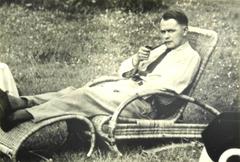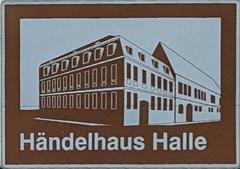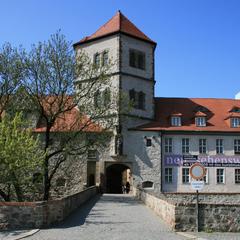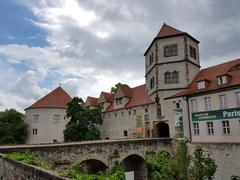
Mesebergbrücke Visiting Hours, Tickets, and Guide to Halle Historical Sites
Date: 03/07/2025
Introduction
The Mesebergbrücke, formerly known as the Hafenbahnbrücke, is one of Halle (Saale)’s most iconic landmarks, blending striking industrial architecture with profound historical significance. Spanning the Saale River, this bridge is not only a vital link in the city’s infrastructure but also a living monument to Halle’s role in the German November Revolution of 1918–1919. Named in honor of Karl Meseberg, a revolutionary leader memorialized on the bridge itself, the Mesebergbrücke stands as a symbol of resilience, social change, and the communal spirit of Halle. This guide offers comprehensive insights into the bridge’s history, design, visitor information, and its role as a cultural hub, especially during Halle’s 2025 thematic year, “Stadt der Brücken. Kommen. Gehen. Bleiben.” (“City of Bridges. Arrive. Depart. Stay.”) (dubisthalle.de, halle-im-bild.de, halle.de).
Table of Contents
- Introduction
- Historical Background
- Bridge Structure and Design
- Visiting the Mesebergbrücke
- Visitor Experience & Practical Tips
- Cultural Significance
- Frequently Asked Questions (FAQ)
- Plan Your Visit
- Summary & References
Historical Background
Halle and the November Revolution
At the turn of the 20th century, Halle was a bustling industrial and railway hub with a vibrant working-class population. The city’s social and economic fabric, shaped by its salt-harvesting and industrial legacy, gave rise to a strong tradition of political activism. During the German November Revolution of 1918–1919, Halle became a center for workers’ and soldiers’ councils demanding democratization, social reforms, and the end of militarism—pivotal in the transition to the Weimar Republic (dubisthalle.de, Wikipedia: Halle (Saale)).
Karl Meseberg: Revolutionary Leader
Karl Meseberg (1891–1919), an Obermatrose (senior seaman) and committed communist, played a leading role in these events as head of Halle’s workers’ and soldiers’ council. He was instrumental in advocating workers’ rights and democratic reforms, including the historic achievement of women’s suffrage in Germany. In March 1919, during violent clashes with right-wing Freikorps, Meseberg was captured, shot, and thrown into the river—his legacy cemented as a symbol of sacrifice and transformation (dubisthalle.de).
Bridge Structure and Design
Engineering and Materials
Constructed between 1893 and 1895, the Mesebergbrücke was designed to serve the harbor railway, facilitating the movement of goods between the Sophienhafen and the Thüringer Bahnhof (halle-im-bild.de). The bridge consists of three main sections: a central metal truss span with distinctive elliptical motifs and two auxiliary bridges at each end. Its unique design eliminates the need for supporting piers in the river, instead resting on abutments and a central river island—giving the structure a “floating” appearance.
The steel latticework typifies late 19th-century engineering, and riveted joints reflect the craftsmanship of the era. Earthen embankments on both sides ensure seamless integration into the surrounding landscape and enable easy access for pedestrians and cyclists (halle-im-bild.de).
Adaptive Reuse
Originally a freight railway bridge, the Mesebergbrücke was repurposed as a pedestrian and cycling route after the decline of industrial rail traffic. This adaptive reuse preserves its historical character while supporting sustainable urban mobility. The absence of vehicular traffic provides a peaceful environment for visitors and uninterrupted views of the Saale River (halle-im-bild.de, The Design Gesture).
Visiting the Mesebergbrücke
Location & Access
Mesebergbrücke is centrally located in Halle (Saale), within walking distance of the main railway station and easily accessible by tram lines 2 and 3 (stop: “Mesebergbrücke”) or bus lines 21 and 22. For drivers, parking is available near the city center (halle365.de).
Hours & Tickets
The bridge is open to the public 24 hours a day, year-round, and free of charge. No tickets are required for access.
Accessibility
The bridge features barrier-free access with gentle ramps, making it suitable for wheelchairs, strollers, and bicycles. Public transport in Halle is also largely accessible.
Guided Tours
Local tour operators and the Halle Tourism Office offer guided walking and cycling tours that include the Mesebergbrücke, providing context on its architectural features and revolutionary history. Virtual tours and digital resources are available via the city’s tourism platforms (verliebtinhalle.de).
Nearby Attractions
Within walking or cycling distance are many of Halle’s top sites, including the Market Square, Moritzburg Castle, Händel House, and the Francke Foundations. Riverside paths and parks invite leisurely strolls and picnics, while the nearby city center offers diverse dining options (verliebtinhalle.de).
Visitor Experience & Practical Tips
Best Time to Visit
The best visiting period is June to September, with warm temperatures and lively cultural events. Spring and autumn offer quieter experiences, while winter can be cold but atmospheric (championtraveler.com, triphobo.com).
Local Activities & Events
The bridge is a popular vantage point for photography, especially at sunrise and sunset. In summer, the surrounding area hosts festivals, open-air concerts, and art installations—many part of Halle’s cultural theme year (halle365.de). Guided historical tours, cycling, jogging, and riverside activities are popular.
Safety & Etiquette
Halle is generally safe, but standard travel precautions are recommended. Respect bike lanes, arrive punctually for tours, and be mindful of event schedules (happytowander.com). Shops often close on Sundays, though restaurants and attractions may remain open.
Practical Tips
- Dress appropriately for the season and bring rain gear if needed.
- Wear comfortable shoes for walking and exploring.
- Pack a camera for the panoramic views.
- Learn a few basic German phrases for a richer experience (germanythingstodo.com).
- Leverage public transport and consider sustainable travel options.
Cultural Significance
Memorial Features
A centrally placed plaque commemorates Karl Meseberg, inviting visitors to reflect on the bridge’s revolutionary history. This memorial transforms the bridge into a site of remembrance and civic identity (halle-im-bild.de, denkmalprojekt.org).
Symbolism & Community Engagement
As part of Halle’s “Stadt der Brücken” theme year, the bridge hosts events and installations exploring themes of connection, transition, and community. It stands as a living metaphor for dialogue and integration—bearing witness to Halle’s industrial growth, wartime division, and reunification while fostering artistic inspiration and public gatherings (halle.de, themenjahre-halle.de, verliebtinhalle.de).
Frequently Asked Questions (FAQ)
Q: What are the visiting hours for Mesebergbrücke?
A: The bridge is open 24/7, year-round, and free to access.
Q: Is the bridge accessible for people with disabilities?
A: Yes, the bridge has barrier-free ramps and is suitable for wheelchairs and strollers.
Q: Are guided tours available?
A: Yes, guided tours can be booked through the Halle Tourism Office or local providers.
Q: How can I get there by public transport?
A: Tram lines 2 and 3, and bus lines 21 and 22, stop near the bridge; it is also a 15-minute walk from the main station.
Q: What nearby attractions can I visit?
A: Market Square, Moritzburg Castle, Händel House, and Francke Foundations are all nearby.
Plan Your Visit
- Explore more: Download the Audiala app for audio tours, interactive maps, and insider tips.
- Check event calendars: For cultural programming and special events on or around the bridge.
- Consult the Halle Tourist Information Office for updated accessibility, maps, and multilingual assistance.
- Stay connected: Follow local tourism websites and social media for news and inspiration.
Summary
The Mesebergbrücke is far more than a crossing over the Saale River—it is an enduring testament to Halle’s industrial legacy, its revolutionary spirit, and its ongoing cultural vibrancy. Open day and night without fees and centrally located, the bridge is both a functional public space and a site of memory and inspiration. Whether you are drawn to its unique architecture, its poignant memorials, or its role as a community gathering place, the Mesebergbrücke offers a rich, accessible, and memorable experience at the heart of Halle.
References
- Visiting the Mesebergbrücke in Halle: History, Tickets, and Travel Tips, 2025, dubisthalle.de
- Mesebergbrücke Visiting Hours, Tickets, and Historical Significance in Halle, 2025, halle-im-bild.de
- Mesebergbrücke in Halle: History, Visiting Hours, Tickets & Cultural Significance, 2025, halle.de
- Visitor Experience and Practical Tips, 2025, verliebtinhalle.de
- Germany Travel Official Tourism, 2025, germany.travel
- championtraveler.com
- triphobo.com
- halle365.de
- germanythingstodo.com
- happytowander.com
- denkmalprojekt.org
- themenjahre-halle.de
- The Design Gesture











